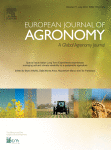Ver ítem
- xmlui.general.dspace_homeCentros Regionales y EEAsCentro Regional Santa FeEEA ReconquistaArtículos científicosxmlui.ArtifactBrowser.ItemViewer.trail
- Inicio
- Centros Regionales y EEAs
- Centro Regional Santa Fe
- EEA Reconquista
- Artículos científicos
- Ver ítem
Contribution of incident solar radiation on leaves and pods to soybeanseed weight and composition
Resumen
The weight and composition of soybean seeds (Glycine Max L. Merrill) depend on changes in carbonand nitrogen assimilate supply during grain filling. Soybean pods and seeds are green, evidencing theircapacity to capture light. However, the current physiological knowledge does not consider any effect ofincident solar radiation reaching the pods on seed weight and composition. The objective of this workwas to investigate the response of seed weight and
[ver mas...]
The weight and composition of soybean seeds (Glycine Max L. Merrill) depend on changes in carbonand nitrogen assimilate supply during grain filling. Soybean pods and seeds are green, evidencing theircapacity to capture light. However, the current physiological knowledge does not consider any effect ofincident solar radiation reaching the pods on seed weight and composition. The objective of this workwas to investigate the response of seed weight and composition to changes in assimilate supply fromleaves, to the incident solar radiation reaching the pods and to the combination of both, changes in assim-ilate supply from the leaves and incident solar radiation on pods of soybean plants. Field experimentswere performed during two growing seasons at Balcarce, Argentina. Treatments modified the amountof assimilates supplied by the leaves (plant shading, defoliation), the solar radiation reaching the pods(pod shading) or both (defoliation and pod shading) during seed filling. Plant shading and defoliationreduced seed weight, oil concentration and oil and protein content and increased the concentration ofsaturated and poli-unsaturated fatty acids while reduced oleic acid percentage. Pod shading increasedthe concentration of stearic acid and reduced the concentration of linolenic acid. When pods were shadedon defoliated plants, seed weight and oil and protein content decreased while fatty acid composition wassimilar to values obtained under defoliation treatment. Based on these results, a conceptual model thatconsiders photoheterotrophic nature of reproductive structures of soybean is proposed. Seed weight, oiland protein content and oil fatty acid composition depended on assimilate availability for the seeds. Theresponse of oil and protein content to assimilate supply depended on whether leaves were present ornot. The effect of solar radiation incident on pods depended on the amount of assimilates available forthe seeds: (i) when carbon allocated was low (defoliation treatments), pods contributed to seed carboneconomy but solar radiation incident on them did not affect fatty acid composition; (ii) when carbonallocated to the seeds was high (intact plants), contribution of pods to seed carbon economy was notsignificant, but the amount of solar radiation incident on pods produced significant changes in fatty acidcomposition.
[Cerrar]

Autor
Bianculli, Mariana Lujan;
Aguirrezábal, Luis Adolfo Nazareno;
Pereyra Irujo, Gustavo Adrian;
Echarte, María Mercedes;
Fuente
European journal of agronomy 77 : 1-9. (July 2016)
Fecha
2017-07
ISSN
1161-0301
Formato
pdf
Tipo de documento
artículo
Palabras Claves
Derechos de acceso
Restringido
 Excepto donde se diga explicitamente, este item se publica bajo la siguiente descripción: Creative Commons Attribution-NonCommercial-ShareAlike 2.5 Unported (CC BY-NC-SA 2.5)
Excepto donde se diga explicitamente, este item se publica bajo la siguiente descripción: Creative Commons Attribution-NonCommercial-ShareAlike 2.5 Unported (CC BY-NC-SA 2.5)

